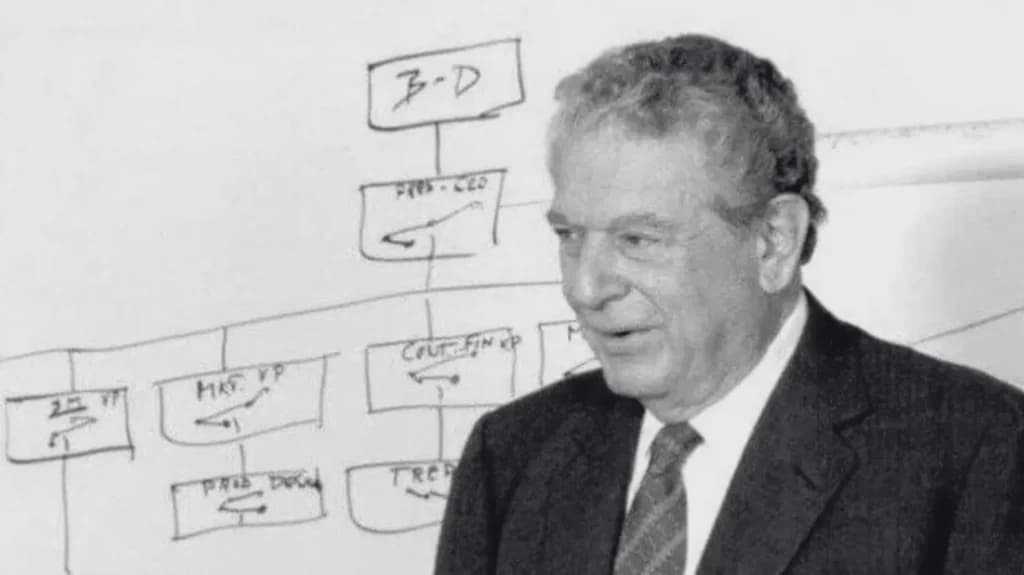
"We can solve business problems through the lens of understanding individuals"
Arnold Daniels
Psychometric Testing Pioneer
- Date
HOW CAN PERSONALITY INDEXING INCREASE MEASURABLE RESULTS?
posted in Business Coaching

Adam Kreek
Personality indexing cuts through the static, enabling your leadership team to connect more effectively with their employees and achieve more productive results. As an executive coaching tool, personality indexing can increase your team’s performance levels and bring meaningful results. For a clearer understanding of personality testing and how it can boost your enterprise’s value, keep reading. To take a Predictive Index Behavioural Assessment right now, click here.
Or, to jump-start your team’s performance immediately, connect with us to discuss how this toolkit can help your team.
In my coaching work, I regularly utilize tools such as the Predictive Index and other personality assessments to help leaders develop self-awareness—the cornerstone of effective leadership. These tools aren’t just about putting people in boxes. They're about opening doors. When we understand our personality drivers—how we’re wired to think, decide, relate, and lead—we start to see the unconscious patterns that have been shaping our behaviour for years. We gain language for our instincts. We clarify why certain environments energize us while others drain us. And we start to identify the friction between who we are and who we’ve been pretending to be.
When leaders integrate this awareness, they begin to act more in alignment with their natural strengths—and just as importantly, their natural needs. This alignment leads to greater satisfaction, increased flow, and improved performance across all domains of life. You stop chasing someone else’s version of success and start building a life and leadership style that’s actually congruent with who you are. That’s where the real power lives. Self-awareness isn’t just a soft skill. It’s a strategic advantage.
Why Personality Indexing for Your Business?
Why is it a struggle to hire, engage, and retain top talent? Why do groups struggle to work together effectively? Why is it so difficult to coach and motivate employees to drive harder to achieve business goals?
Personality tests are useful tools to help you manage better, lead better, make better hires and engage employees more effectively. After taking a test, you will know yourself, your colleagues and potential hires. When used effectively, I have seen personality tests increase the likelihood of a successful new hire, foster a strong team culture, and enhance business performance.
With a good personality indexing program, you can reduce risk while also increasing the effectiveness of:
- Hiring and selecting unknown candidates
- Equipping managers to drive results
- Conflict reduction measures
- Culture-building programs
- Career path development
- Employee onboarding
- Designing company reorganizations
- Strong teams
- Succession planning
- Internal promotions
On average, 55 percent of a company's costs are related to hiring and paying employees. So, why not use a system that is validated by science to better craft your company culture?
Consider this:
- Half of all new business hires fail within 18 months. If you save one bad hiring decision for an employee who is paid $70,000 per year, your ROI is between 2x and 5x the annual cost of hiring an executive business coach.
- By increasing your employee engagement investments by ten percent, you can increase profits by $2,400 per employee per year.
An organization that uses personality tests will establish a common language to frame identity and build trust through effective communication. On the surface, you will start the assessment by reading your score, but finish with a deeper understanding of yourself and the others you work with.
Interested? Take a Predictive Index Behavioural Assessment here!
Risks of Personality Indexing
However, there are real risks in personality assessments. And the devil is in the details. Like humans, personality tests are nuanced. When using a personality test for business performance, you should pick one that is scientifically validated and measures character traits that are directly related to business performance.
Personality assessments are not destiny. People can create workarounds to deal with natural tendencies. This tool aims to provide the best estimate of how someone will perform in their job.
The best leaders do not behave the same as one another, nor do the best police officers, nor the best salespeople.
While excellent performers in a certain role will achieve the same excellent outcome, it turns out that the styles and methods for delivery vary from person to person. Excellence at work is always idiosyncratic.
A common criticism of personality tests is that the results are determined from self-reporting by employees or potential employees. However, research indicates that the most honest individuals tend to complete these reports accurately. When people do fudge their tests? They are low performers and rank far below top individuals, anyway.
All said, if you know the benefits and the risks, you can use personality assessments to make better hires, be a better leader and increase engagement.
To take a Personality Behavioural Assessment click here!
PROS of Personality Indexing for Business
- Employers can see how a candidate may fit into the team, job demands and company culture.
- Managers can use results to understand how to better communicate with and provide feedback to employees.
- Personality tests provide a relatively unbiased, consistent means of assessing candidates and employees.
- Personality tests look into what a candidate will do in a given situation versus what he or she has done.
- Personality tests can be fun for candidates to take and can boost self-awareness and job satisfaction.
CONS of Personality Indexing for Business
- Employers may assess a candidate’s job fit based entirely on test results.
- Managers can lean too heavily on the test results, miss out on important communication opportunities, and fail to connect authentically.
- Not every candidate or employee may take the personality test seriously and/or not have the capability to fill the test out to the best of his or her ability.
- Companies may administer the wrong personality test for the wrong situation.
- Personality tests can be costly and time-consuming for companies, candidates, and employees alike.
What Types of Personality Indexing Exist?
Personality indexing is a type of psychometric testing that measures and quantifies personality traits. They are the modern-day version of personality tests. Personality indexing allows us to review and understand why we interact with others the way we do and glean insight into our personality strengths and weaknesses.
The information obtained from a personality index screening can help us better understand individual personality and further our journey towards self-actualization. Leadership-minded executives who encourage self-actualization processes through team coaching services achieve improved work ethic and productivity.
Examples of regarded personality indexing tools include:
- DISC
- Myers-Briggs Type Indicator
- Enneagram Testing
- Big 5 Personality Traits
- The Predictive Index
Each tool varies in methodology, delivery, interpretation, and structure, but all are designed to improve self-awareness and the collective understanding of the people who make up your teams. Each test has a certain overlap with the others and can deliver effective results. This is not an extensive list.
The graphic and table below attempt to find similarities between the different psychometric tests listed in this article.
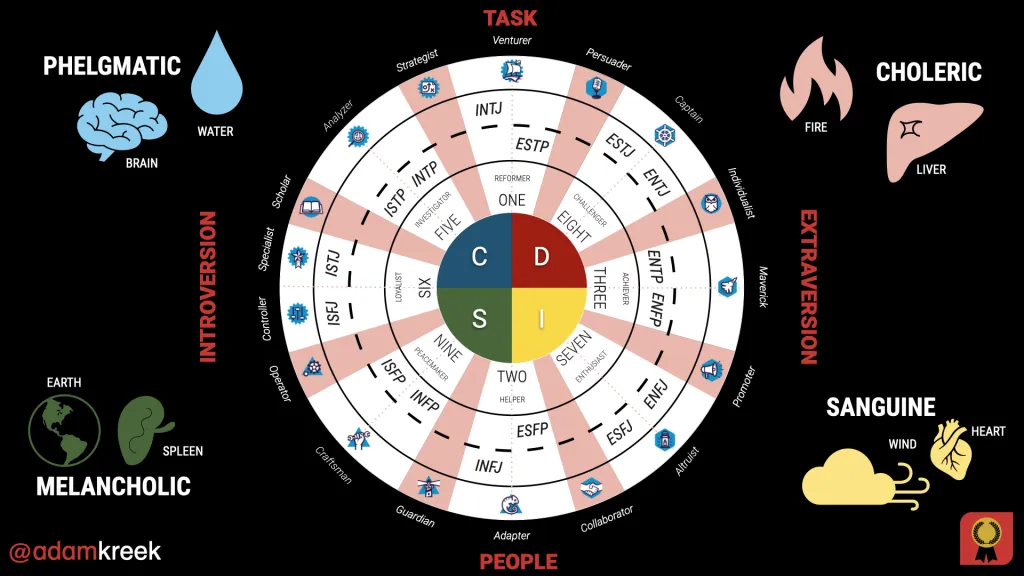
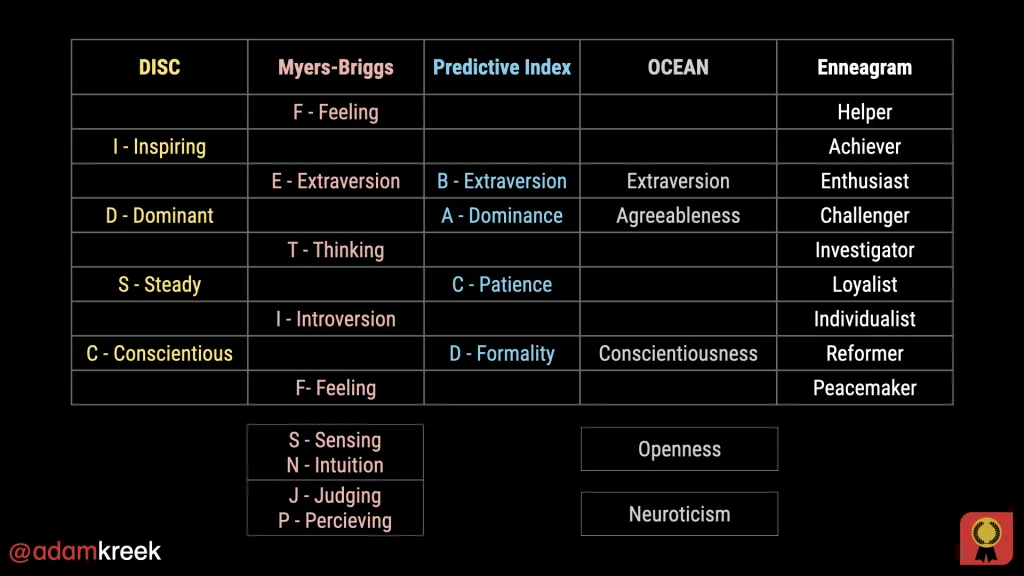
The Predictive Index Behavioural Assessment
Developed in 1955 by Arnold Daniels, the Predictive Index (PI) is today’s top personality testing resource used by executives and organizations to determine how best to manage employees. Based on scientific research and supported by psychologists, the PI testing system examines four key drivers and categorizes individuals into 17 distinct personality types.
- Dominance is the drive to exert influence on people or events.
- Extraversion is the drive for social interaction with other people.
- Patience is the drive to have consistency and stability.
- Formality is the drive to conform to rules and structure.
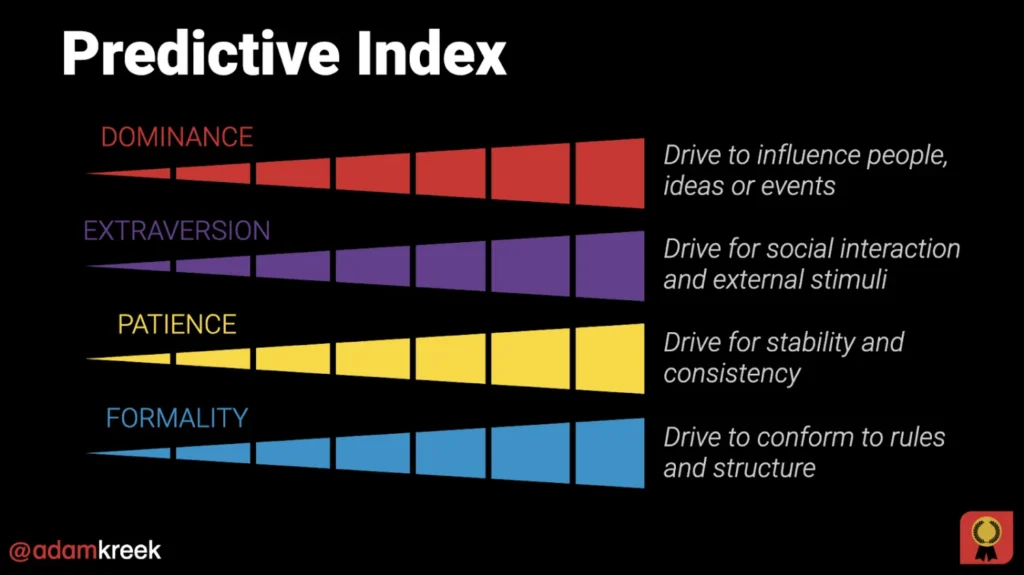
Objectivity and subjectivity are also measured. It is the degree to which individuals prefer to layer their personal experiences over their decisions and information processing.
These four key factors—or key behavioural drives—provide a simple framework for understanding your employees’ and candidates’ workplace behaviours so that we can see beneath the surface and predict how people will behave in given situations.
Interested? Take a Predictive Index Behavioural Assessment here!
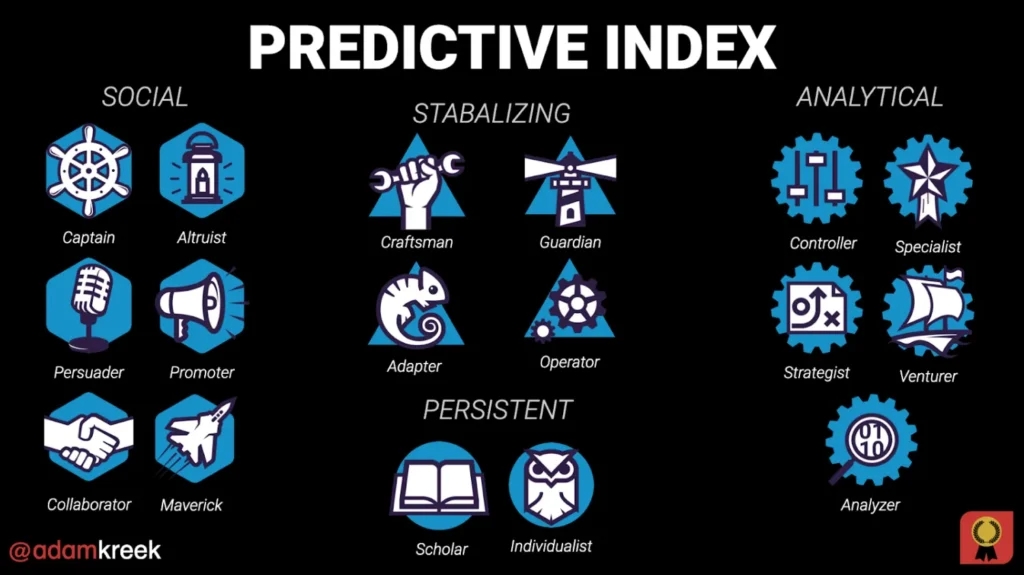
Myers-Briggs Type Indicator
After decades of research, the mother-daughter team that developed the Myers-Briggs Type Indicator in 1956 sought to help bring women into the workforce. Based on their own observations and the work of esteemed psychiatrist C.G. Jung, the two created a questionnaire that identifies sixteen different personality types.
Like other personality indexing theories, the Myers-Briggs Type Indicator has four dichotomies, from which the remaining fourteen personality types are derived. Originally known as the MBTI test, the test has become the basis for several personality testing products available today, including the 16 Personalities Test and Cattrall 16 Personalities Test.
Four dimensions of personality are measured:
- Where does your energy come from? Introversion – will being alone with ideas light you up, or Extraversion – will being with other people or processes light you up?
- How do you process information? Sensing, do you need the facts? or Intuition, do you follow your gut instincts?
- Where are your decisions based? Thinking, are you more level-headed in your choices? Or, Feeling, are you more empathetic and consult your personal values when making choices?
- How do you organize your life? Judging, do you like rules and deadlines? Or Perceiving, do you embrace being spontaneous and flexible?
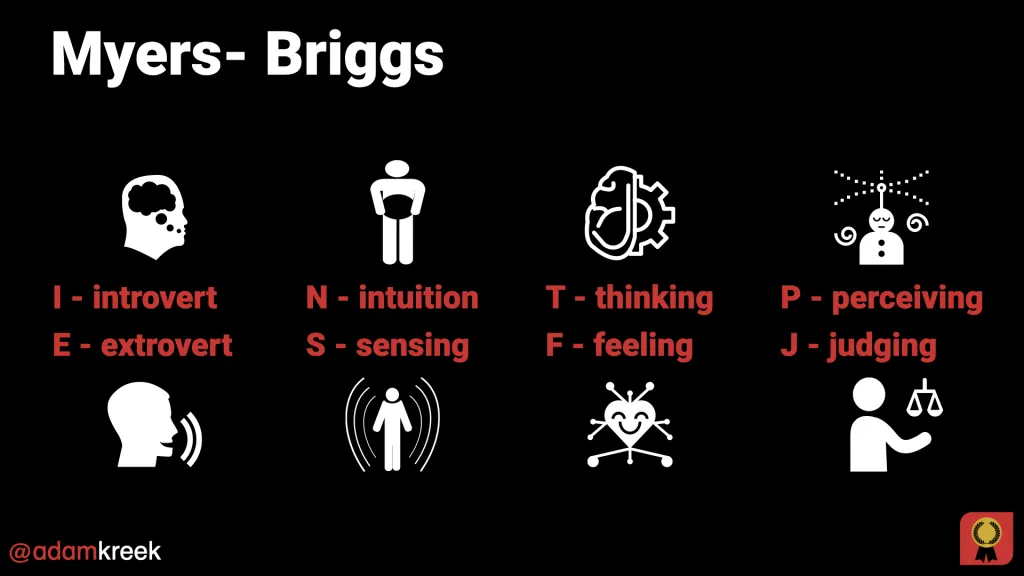
Enneagram Testing
The Enneagram of Personality, which provides the theory for Enneagram testing, divides human personality traits into nine categories and allows connections between each category. This circle of connected traits, whose development is largely credited to Oscar Ichazo, is referred to as an enneagram.
Enneagram testing is primarily focused on personal growth and spiritual development rather than leadership enhancement and productivity. While not often used by organizations for human resource development, the Enneagram Personality test is useful to encourage self-actualization and value discovery.
The personality types are:
- Reforming Perfectionist
- Helping Giver
- Achieving Performer
- Romantic Individualist
- Investigating Observer
- Loyal Skeptic
- Epicurean Enthusiast
- Challenging Protector
- Peacemaking Mediator
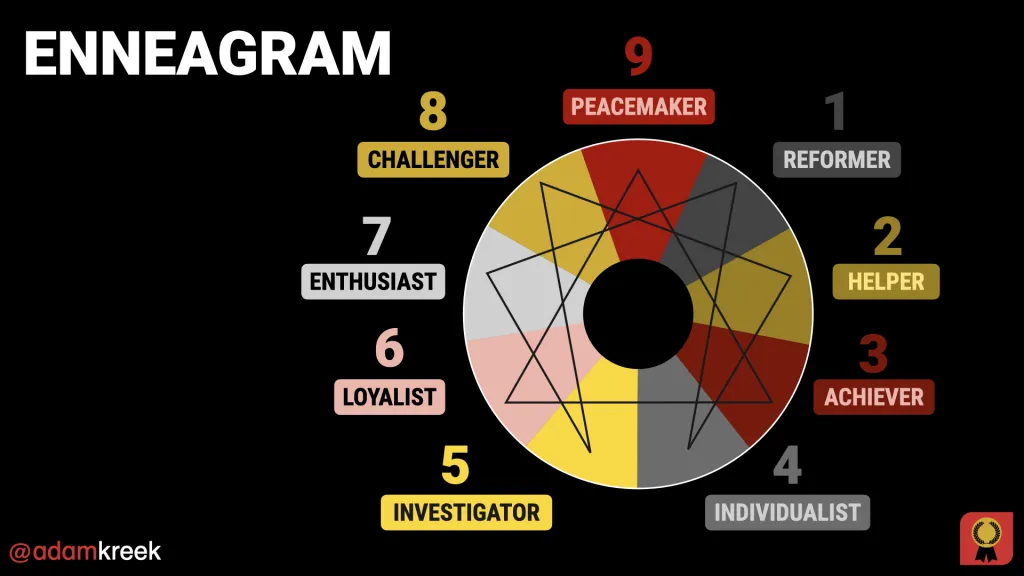
DISC
DISC is a personality test anagram that stands for Dominance, Influence, Steadiness, and Conscientiousness. Endorsed by leading executive coaches and influencers, such as Tony Robbins, the DISC personality test is designed to achieve both personal and professional growth.
Developed initially by Dr. William Marston -- who also created the comic book character Wonder Woman—the DISC theory was further developed and honed by Walter Clark in 1956. Today, the DISC test remains a reliable tool for developing solutions to leadership and managerial challenges.
The DiSC model discusses four reference points as they exist over two spectrums - introversion/extraversion and task/people orientation:
- Dominance – direct, strong-willed and forceful
- Influence – sociable, talkative and lively
- Steadiness – gentle, accommodating and soft-hearted
- Conscientiousness – private, analytical and logical
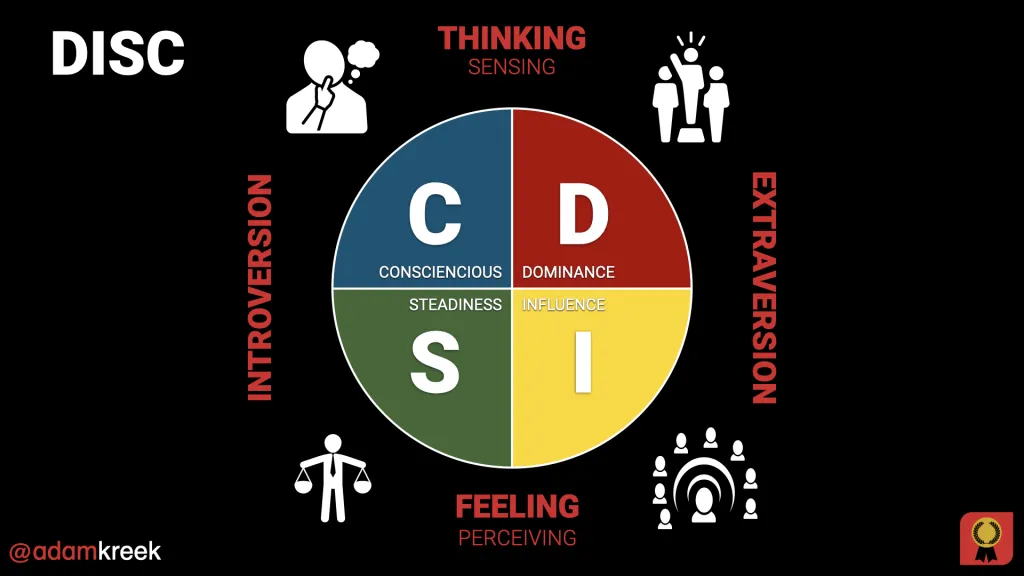
The Big 5 Personality Traits
Commonly known as “The Big 5,” the Big 5 Personality Trait theory goes by multiple monikers, including:
- The Five-Factor Model (FFM)
- OCEAN
- CANOE
University of Chicago psychologist Donald Fiske established this theory of personality in the '40s, then further developed in subsequent decades. Personality traits are broken into five sections:
- Openness to Experience
- Conscientiousness
- Extraversion
- Agreeableness
- Neuroticism
Each personality trait exists on a spectrum between two extremes. For example, neuroticism represents a continuum between extreme sensitivity and nervousness and extreme confidence. In reality, most of us lie somewhere in between the two polar ends of each dimension.
Longitudinal studies suggest that our Big Five traits are relatively stable throughout adulthood. One study of working-age adults found that personality traits displayed little change in the face of adverse life events, and these traits tended to remain stable over a four-year period.
Studies also show that maturation impacts the five traits. As we age, we tend to become less extroverted, less neurotic, and less open to new experiences. Agreeableness and conscientiousness, on the other hand, tend to increase as we age.
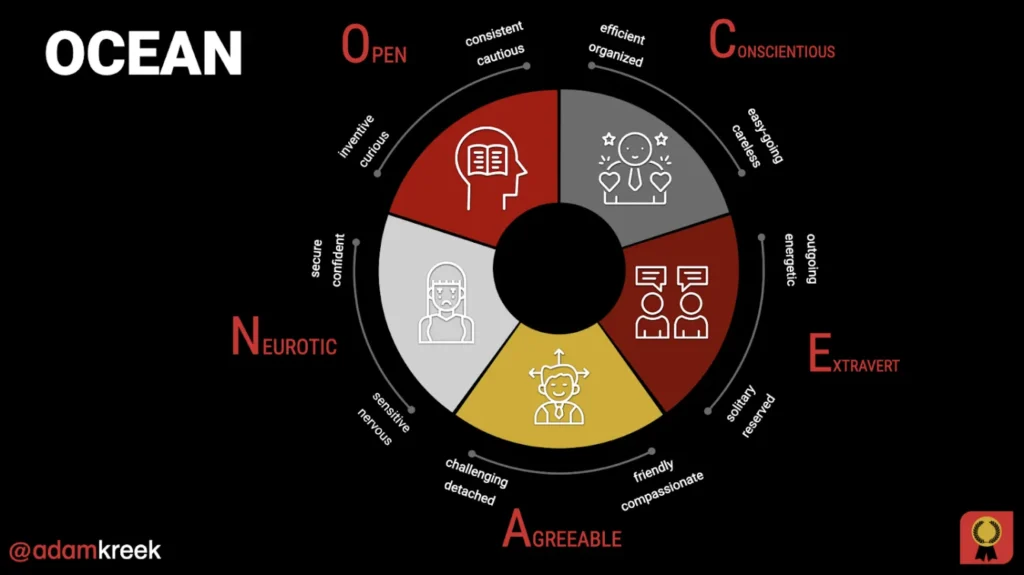
History of Personality Testing
Human behaviour has baffled and bemused the human race since time immemorial. The first known system used to classify personality traits dates back to Ancient Greece and one of the first psychologists, Aelius Galenus, who was part of the medical theory of humoralism. The great philosophers broke down the different personalities into four categories, each connected to one of the four physical humours: blood, yellow bile, black-bile, and phlegm.
The four personality traits of the humorous philosophy are called temperaments and are classified as follows:
Sanguine. Sanguines are extroverted, enjoy the company of others and are highly energetic. This is connected to the blood humour.
Melancholic. Those with melancholic personalities have a strong connection to black-bile humour. Melancholic people tend to be deep thinkers, detail-oriented, and are typically introverted.
Choleric. Choleric individuals are achievers, goal-oriented, and highly energetic. Their personality traits correspond to the yellow bile humour.
Phlegmatic. To have a phlegmatic personality means to be connected to the phlegm humour and have an easy-going and relaxed nature.
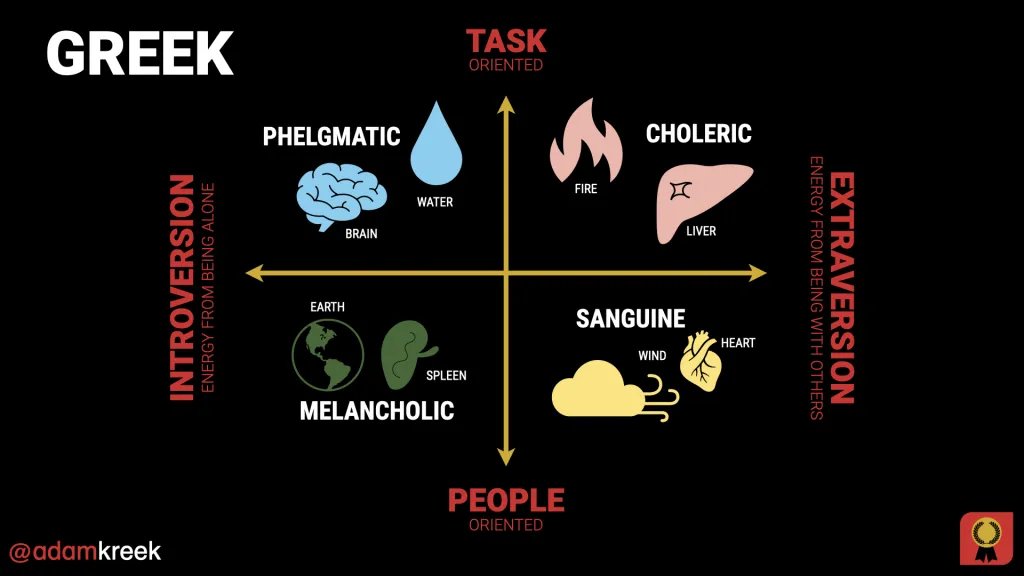
While the theory of the four temperaments was the accepted belief for about 2000 years, at the turn of the twentieth century, the field of psychometrics gained momentum. The American military adopted the early use of personality testing as part of its recruitment process during the First World War. In 2020, the US Army still used personality testing as part of its enlistment and placement process. However, the modern version of a personality test looks much different from its original counterpart.
Personality theories developed by Carl Jung and Isabelle Briggs-Meyer during the 20th century have led to the personality testing strategies used today by psychologists, employers, and individuals. The purpose of the personality test is to understand different traits, create stronger work cultures, and gain valuable insight into individual personality styles.
Why Personality Indexing Works for Businesses
Leaders who employ personality indexing as part of their team development or personal growth strategy discover benefits that help improve their work environment and leadership skills. They are useful tools for creating cohesion and unity within an organization.
As a leadership team, it’s important to invest in the personal development of your team members and employees. When we invest in the individuals that we’ve chosen to be with us as we reach the next milestone, achievement, or growth goal, we increase the value of our enterprise.
When used as part of an executive coaching strategy, professional personality indexing can generate an ROI of over two hundred percent and improve productivity by eighty-six percent. Additionally, employee satisfaction and company loyalty are increased for individual employees.
Interested? Take an Index Behavioural Assessment here!
Bring Success to Your Team with Personality Indexing
Your team’s performance cannot succeed without effective collaboration and communication among team members. Develop a coaching strategy that includes personality testing as an effective way to generate active connections, unity, and industry success. ViDA has executive coaching skills that mid-level managers and executives will benefit from and get results.
Check out our other blog posts!
–––––
Adam Kreek is on a mission to positively impact organizational cultures and leaders who make things happen.
Kreek is an Executive Business Coach who lives in Victoria, BC, near Vancouver, British Columbia, Canada, and Seattle, Washington, USA, in the Pacific Northwest. He works with clients globally, often travelling to California in the San Francisco Bay Area, Atlanta, Georgia, Toronto, Ontario and Montreal, Quebec. He is an Olympic Gold Medalist, a storied adventurer and a father.
He authored the bestselling business book, The Responsibility Ethic: 12 Strategies Exceptional People Use to Do the Work and Make Success Happen.
Want to increase your leadership achievement? Learn more about Kreek’s coaching here.
Want to book a keynote that leaves a lasting impact? Learn more about Kreek’s live event service here.
Other popular blog posts:
Discover the ViDA Values Framework, a structured approach to defining and living your core values. Read this
After 18 years and thousands of speeches, here’s what Kreek has learned about motivating any audience—without the fluff. Check it out